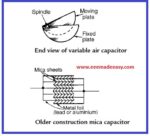Transients
Transients are the surges or spikes in electric currents and voltages which are transmitted
through power or data lines.
The gadget shown in the above picture is claimed to protect the equipment against such surges or spikes
steady currents
when a circuit is connected to a d.c. generator or a battery is called the steady current.
Similarly, the alternating current which flows in a circuit when connected to an alternator is also called the steady current.
These currents are known as steady currents because in such cases,
(i) the circuit components are constant and (ii) the circuit has been connected to the generator long enough for any disturbance produced on initial switching, to resolve itself.
In general, transients disturbances are produced whenever
(a) an apparatus or circuit is suddenly connected to or disconnected from the supply,
(b) a circuit is shorted and
(c) there is a sudden change in the applied voltage from one finite value to another
The transients produced whenever different circuits are suddenly
switched on or off from the supply voltage.
the resultant current consists of two parts (i) a final steady-stage or normal current and (ii) a transient current
superimposed on the steady-stage current.
It is essential to remember that the transient currents are not driven by any part of the applied
voltage but are entirely associated with the changes in the stored energy in inductors and capacitors.
Since there is no stored energy in resistors, there are no transients in pure resistive circuits.
Types of Transients
There are single-energy transients and double-energy transients.
Single-energy transients are those in which only one form of energy, either electromagnetic or electrostatic is involved as in R-L and R-C circuits.
However, double-energy transients are those in which both electromagnetic or electrostatic is
involved as in R-L-C circuits Transient disturbances may be further classified as follows :
(a) Initiation Transients: These are produced when a circuit, which is originally dead, is energised.
(b) Subsidence Transients: These are produced when an energized circuit is rapidly
de-energised and reaches an eventual steady stage of zero current or voltage, as in the case of short-circuiting an R-L or R-C circuit suddenly.
(c) Transition Transients: These are due to sudden but energetic changes from one
steady state to another.
(d) Complex Transients: These are produced in a circuit which is simultaneously
subjected to two transients due to two independent disturbances or when the disturbing force producing the transients is itself variable.
(e) Relaxation Transients: In these transients, the transition occurs cyclically towards
states, which when reached, become unstable themselves.
A distinction may also be made between free and forced transients which are produced due
to the applied voltage being itself transient.
- Environment MCQ for RRB JE CBT 2|Objective Questions Environment for Competitive Exams
- RRB JE CBT 2 Computer Awareness Book Arihant|Objective Computer Awareness Book 2025
- RRB JE CBT 2 Exam Date 2025 Postponed|RRB JE CBT 2 Exam Date
- [PDF]RRB JE Result 03/2024 Cut off, Selected no of candidates for all regions
- [PDF]Final Answer Key Junior Instructor Mechanic Agricultural Machinery|643/2023 Solved Question paper
- Acoustics MCQs|Industries Extension officer|IEO 2025
- LASER MCQs| Industries Extension officer|IEO 2025
- Practical Types of Capacitors
- [PDF] Syllabus JUNIOR INSTRUCTOR MECHANIC AGRICULTURAL MACHINERY|643/2023 Syllabus Kerala PSC
- [PDF] Syllabus JUNIOR INSTRUCTOR WOOD WORK TECHNICIAN|674/2023 Syllabus Kerala PSC
- [PDF] Syllabus JUNIOR INSTRUCTOR MECHANIC CONSUMER ELECTRONIC APPLIANCES|670/2023 Syllabus Kerala PSC
- [PDF] Junior Instructor Hospital Housekeeping| 646/2023 syllabus Kerala PSC








